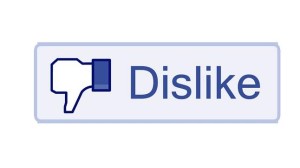How a ”˜dislike’ button could make Facebook more money
Facebook’s famous “like” button, with its silhouette of an upturned thumb, will soon be accompanied by an alternative: a way to “dislike” a post.
On Tuesday, Mark Zuckerberg, the company’s co-founder and chief executive, said that Facebook was “very close to shipping a test” of a dislike button. He suggested that the new button would probably be more nuanced than a simple thumbs-down option. His comments nevertheless raised the possibility that Facebook, the world’s largest forum for self-expression, could soon become a less friendly place.
“You don’t want to go through the process of sharing some moment that was important to you during your day and have someone down-vote it,” Mr. Zuckerberg said as he announced the project during a town-hall-style discussion with users at the company’s Silicon Valley headquarters.
But Facebook users ”” there are now 1.5 billion, the company says ”” have long requested a way to express negative emotions or empathy with something sad or tragic posted on the social network, he said.
“Not every moment is a good moment, and if you are sharing something that is sad, whether it’s something in current events, like the refugees crisis that touches you, or if a family member passed away, then it may not feel comfortable to like that post,” Mr. Zuckerberg said. “So I do think it’s important to give people more options than just like.”
The prospect of a new dislike button has been polarizing among Facebook users.
“There is already enough hate on Facebook and social media,” Atiq Haneef of Pakistan commented on an earlier version of this article on the Facebook page of The New York Times. “I’m gonna dislike this dislike button!”
But Roger Anderson of Atlanta, a former government microbiologist, wrote, “What’s wrong with a dislike button? Let’s have varying opinions on Facebook posts! If some feelings get hurt, then so be it and just grow up.”
Debra Aho Williamson, a social media analyst at the research firm eMarketer, said that it was difficult to imagine a single button that could convey the complex range of negative emotions someone might want to express in response to a Facebook post.
While there is already plenty of negativity in the comments on Facebook posts, making it easy to dislike something with the flick of a finger could make the social network a meaner, uglier place.
“We’re about to enter the busiest time of the election season. Good Lord ”” ”˜dislike’ on that would be a huge flaming mess,” Ms. Williamson said.
As for Facebook’s business ”” selling ads ”” a dislike button could cut both ways. It could increase the level of engagement that people have with posts, and therefore the number of ads they eventually see. But a dislike button could also be disconcerting to marketers, who prefer their messages to be surrounded by happy emotions.
“Over all, it’s probably a good thing to enable people to express feelings and emotions that they can’t express through a like button,” Ms. Williamson said. “But Facebook needs to be careful as to how they enable that capability with regard to advertising and all the potentially inflammatory discussions that could occur online.”
Mr. Zuckerberg clearly has such concerns in mind. He stressed that Facebook would test the new button before introducing it broadly, and refine it based on user feedback. “Hopefully we’ll deliver something that meets the needs of our community,” he said.
Facebook’s decision to experiment with a new button came after much deliberation. In December, Mr. Zuckerberg told a similar meeting of users that the company had been working on the idea but had not figured out how to add a dislike button “so that it ends up being a force for good and not a force for bad.”
Gina Bianchini, chief executive of Mightybell, which builds and runs social networks for businesses, said that Facebook had been smart about making it easier for users to express more nuanced feelings, and that she expected the new button would be a positive addition to conversation on the social network.
“All social networks are getting more sophisticated about this,” Ms. Bianchini said. “People want to express more through a button. It’s so much easier to press a button than typing a lot.”
– Vindu Goel, BRW
Short URL: https://indiandownunder.com.au/?p=5555

